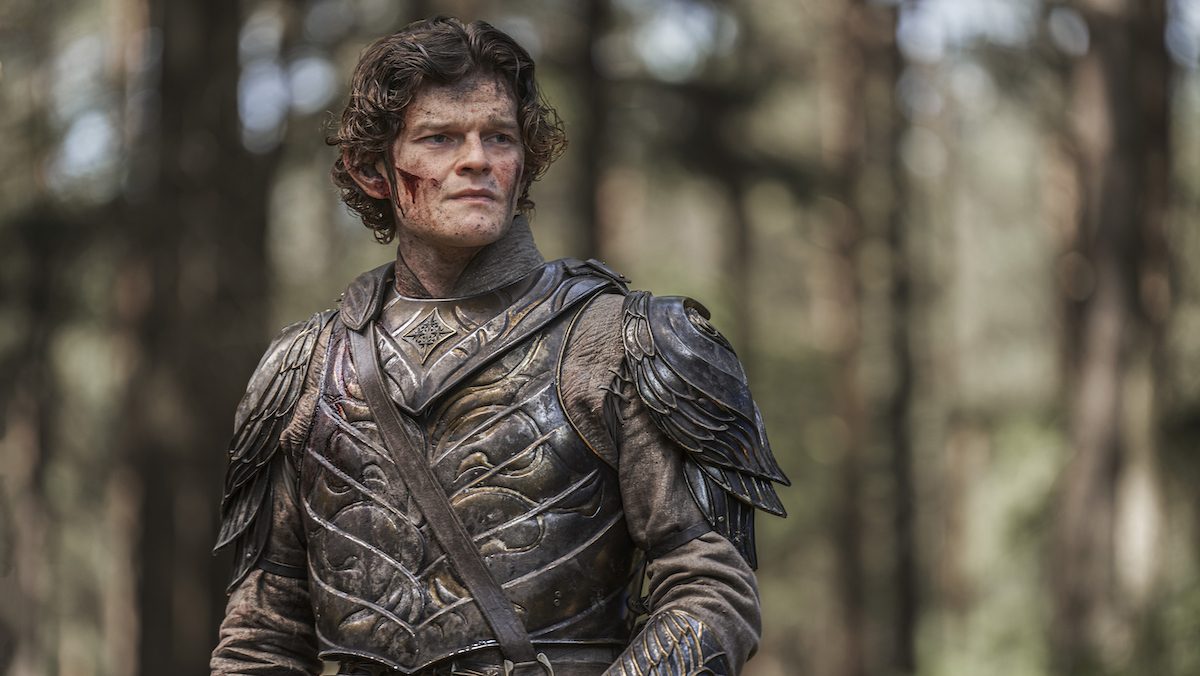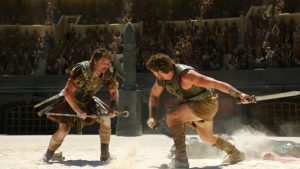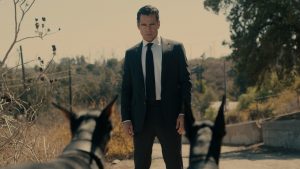
This Lord of the Rings: The Rings of Power article contains spoilers.
The penultimate episode of The Lord of the Rings: The Rings of Power’s second season is the series’ biggest and boldest installment to date, a sweeping spectacle that rivals anything achieved in Peter Jackson’s trilogy of films. The long-promised battle for Eregion that has been teased since the first season 2 trailer is truly epic, in every sense of the word. The fighting, which features thousands of elves and orcs, a sweeping cavalry charge, impressive swordplay, flaming projectiles, massive explosions, and even a hill troll, is of a scale that is rarely seen outside studio blockbusters. And its consequences, if J.R.R. Tolkien’s writing is anything to go by, promise to be both devastating and far-reaching.
It’s also something that’s never been depicted onscreen before. While the siege of Eregion is one of the most brutal battles of the Second Age and its aftermath shapes much of Middle-earth as fans of Jackson’s film will recognize it, from the founding of Rivendell to the closing of the Doors of Durin in Khazad-dûm, it’s also an event that’s only briefly described in Tolkien’s histories. That it now exists as a sprawling, multi-episode tour de force is the sort of gift many fans have been dreaming about for decades.
“It is a really cool moment in Tolkien’s legendarium, so to bring it to life was really special,” Charlie Vickers, who plays the Dark Lord Sauron, tells Den of Geek. “I just saw it for the first time last night, and it blew me away.”
Though The Rings of Power plays a bit fast and loose with some of the few specifics we know—Adar, after all, is both the inciting force behind this conflict and a character who doesn’t technically exist in Tolkien’s text—the Prime Video adaptation works overtime to give this pivotal moment in Middle-earth history its proper weight.
“We don’t exactly tell the story of the siege of Eregion the way Mr. Tolkien wrote it,” Robert Aramayo, who plays Elrond, says. ”It’s slightly different based on the context of the show, but the spirit is the same, and that’s something the showrunners and I talked a lot about.”
“Doomed to Die” is a fairly grim hour, which sees the elves of Eregion overwhelmed by the combination of Adar’s forces and Sauron’s behind-the-scenes manipulation. There’s a great deal of death, widespread destruction, and a steadily increasing sense of dread, as it becomes increasingly clear this may not be a battle that Elrond and the elves can win.
“My focus throughout was just trying to put Elrond through this experience in the most authentic way I could,” Aramayo says. “I wanted him to be desperate. I wanted him to be not as skilled as the other elves around him. But that’s so you can feel his heart and his desire to save the city, and realize that’s what’s pushing him forward the whole time.”
Located in the shadow of the Misty Mountains, Eregion is not just the location of Celebrimbor’s famed forge, but a legendary seat of elven creation. It’s not just an important city or a notable place on a map, but a symbol of everything elven kind both stands for and believes in. (Elrond himself says its fall “would be a mortal blow for all of Middle-earth”.) No wonder putting its destruction together involved months of filming and an equally expansive team behind the cameras.
“It’s like building a gigantic puzzle,” Rings of Power director Charlotte Brandstrom says when asked about her approach to tackling these sequences. “I remember the first day they took me to the place where we were supposed to do the battle. And it was just a very boring field in the middle of the woods. And I thought, ‘Oh, my God, we have to invent everything from scratch.’ But, I always start by building miniature models to sort of decide how the battle should progress. And, obviously, you follow the script, and you know where you stand in the story, and who’s doing what. So you go from there—you figure out the pieces and you build it. Like building a house, one piece at a time.”
While the sheer scale of this episode can feel almost overwhelming at times, it was important for Brandstrom to balance its biggest action sequences with key character moments.
“I always try to tell a story, whatever I do. And there is a lot of performance and a lot of storytelling in action. So, I focused on that,” Brandstrom says. “[Because] it’s not only about the fighting on the battlefield, you also need to try to do as much as you can to explain not only who is standing where, but what’s at stake, and what they’re trying to accomplish.”
But while this focus gave Brandstrom a “roadmap” to follow, the actual filming process was more than a bit challenging: “The scope never felt too big, because you really can prepare for anything,” she laughs when asked about the sheer size of the onscreen battle she was tasked with bringing to life. “But it was tough.”
During the battle, Adar’s decision to dam the river that protects Eregion from attack is a turning point in the orcs’ assault, allowing them much easier access to batter the city’s walls. But it required the series’ cast and crew to work in some…let’s just call them occasionally difficult conditions.
“It was [filmed in] a riverbed that was actually drained, and we had to do the fights on the riverbed. That meant we needed a lot of mud. The problem is, not only did we put in a lot of mud, but it was also raining all the time. Which made even more mud,” Brandstrom says. “So even just walking around, let alone running, the actors would get stuck in it. I fell half into a hole and someone had to come carry me out. It was everywhere, this mud. It was up to our knees! And it was raining, raining, raining, constantly. Plus we were up all night, and it was like that for a whole month.”
Since Elrond is one of the primary focal characters throughout the battle, Aramayo had to deal with some of the most difficult stretches of filming.
“It was a really, really challenging period,” Aramayo says. “It took forever. There was so much fighting that had to change regularly. There was a writer’s strike. So many night shoots. So much mud. At the beginning of the battle, you’re in all this clean and shining armor and you think, ‘Wow, God, this actually looks kind of cool.’ But by the end of it, I’d just be trudging back to the tent at four in the morning, literally dripping, soaking wet, and covered head to foot in mud and rubbish. So for me, the transformation of Elrond, and what he goes through during the battle, it was definitely linked with what I was going through [on set].”
Stakes are high for many characters in this episode, as Celebrimbor finally clues into Sauron-as-Annatar’s treachery, Durin considers overthrowing his father’s rule, and Galadriel finds herself at Adar’s mercy. But it is Elrond who is beaten down both literally and figuratively over the course of a battle that feels increasingly doomed.
“Episode seven, it’s very much about Elrond’s emotional journey,” Brandstrom says. “He knows at the beginning of the battle that he needs to hold everything until Durin gets there in the morning at dawn, and he expects Durin to show up. And then when he realizes he’s not there, that he’s maybe not coming…that’s when he gives up.”
Elrond’s desperate insistence that Durin will come to his aid despite all current evidence to the contrary is a heartbreaking moment to end this episode on, but one that conveys the immense weight of the battle unfolding around him.
“There’s definitely an Elrond before this battle and an Elrond after this battle,” Aramayo explains. “I think the kind of brutality he experiences and sees around him through the orcs and even finds within himself a bit, it’s something I don’t think he’s ever experienced before. It brings something out in him that he doesn’t expect, a sort of mortality, I would say. It highlights the human part of him, which is very real.”
Vickers’ experience filming this episode was somewhat different, given that Sauron himself doesn’t directly take part in the larger battle. Instead, he uses his unrivaled skill at manipulation to influence and direct others behind the scenes inside Eregion, claiming increasing power and control for himself.
“I’m never truly on the battlefield, but I was there in little scenes. I got to experience little moments of [Eregion] crumbling all around me,” Vickers says. “That was cool. And I heard a lot of anecdotal things from people. Rob was in the mud all the time, apparently. But there were so many moving parts. Charlotte did such an amazing job.”
For Brandstrom, it was important to balance the chaos of the battle scenes with the quieter, if no less dark, moments taking place in Celebrimbor’s forge.
“I find that intercutting [the fighting] with this very strong, dramatic, almost psychological thriller happening between Celebrimbor and Sauron was very effective because it gave us a different dynamic to work with,” Brandstrom says. “A whole film cannot be too quiet, and it cannot be too loud, you need different kinds of moments, and different things to focus on.”
In many ways, the intercutting of the visions of peace and prosperity Sauron has convinced Celebrimbor are real with the screaming violence of reality do more to convey the horror of war and the scope of Eregion’s ruin than a dozen sequences featuring trebuchets and battering rams. And that’s on purpose, to some extent.
“I very much believe in creating disruptions in a film, it helps keep the audience’s attention,” Brandstrom says. “If you live in a house near the ocean and you hear waves all the time, after a few days you don’t hear them anymore. You can get used to anything. So it’s very important to create those [moments] so that when you go into the quiet of the forge, you really feel the quiet and the impact of [Celebrimbor’s] emotional journey. And then you go back out [into the battle]. That constant contrast, I really, really liked that. It’s probably my favorite episode, episode seven, for that reason.”
The Lord of the Rings: The Rings of Power is streaming now on Prime Video.
The post The Rings of Power: The Siege of Eregion Is the Series’ Biggest (and Bloodiest) Battle Yet appeared first on Den of Geek.





